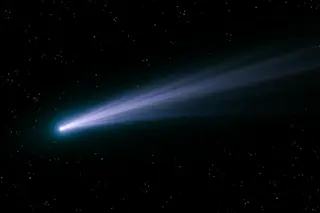Comet Hyakutake’s close pass by Earth in late March brought more than spectacular sky watching for backyard astronomers: it was the first time a comet was found to emit X-rays. Aiming the X-ray-detecting rosat satellite at Hyakutake, astronomers from nasa’s Goddard Space Flight Center and the Max Planck Institute for Extraterrestrial Physics in Germany spied a crescent-shaped glow extending some 30,000 miles in front of the coma, the thick layer of gas and sunlight-scattering dust streaming off the comet’s nucleus. When the German astronomers later reviewed data collected by rosat during an all-sky survey in 1990, they found four more comets that had produced X-rays. That tells us that Hyakutake was not a fluke, says Carey Lisse, leader of the Goddard team. All comets probably give off X- rays to some degree.
Astronomers aren’t sure how the X-rays are generated, but the energy must come from the sun. One possible ...














